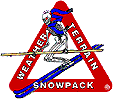[Click here to return to the page you came from!]
Loose Snow Avalanche
Also: Point Release, Sluff
A sluff can refer to any small avalanche, but usually refers to small, loose-snow avalanches.
When snow grains have low cohesion between them they will have a low angle of repose, and on slopes of greater steepness than this angle the snow will slide. Due to the low cohesion the slide will start from a point and gather more snow as it descends. The resulting path is typically an inverted V shape.
Snow grains can have low cohesion between them for a variety of reasons. In cold conditions new snow may initially have low cohesion between the crystals (until some settlement takes place) and dry loose snow avalanches (or sluffs) can occur. In warm conditions, or with rain, snow grains may have low cohesion due to an excess of water in the snow and wet loose snow avalanches (or sluffs) can occur. Metamorphism can also result in surface layers of snow faceting and loosing cohesion between the grains.
The important practical thing about loose snow avalanches or sluffs is that they are much different in nature than slab avalanches. Few injuries or fatalities result from loose snow avalanches. They can be especially dangerous if there is a terrain trap below, such as a cliff band to be carried over or a narrow ravine or a crevasse to be buried in.
This glossary is a work in progress and is made possible by AlpenPro.



